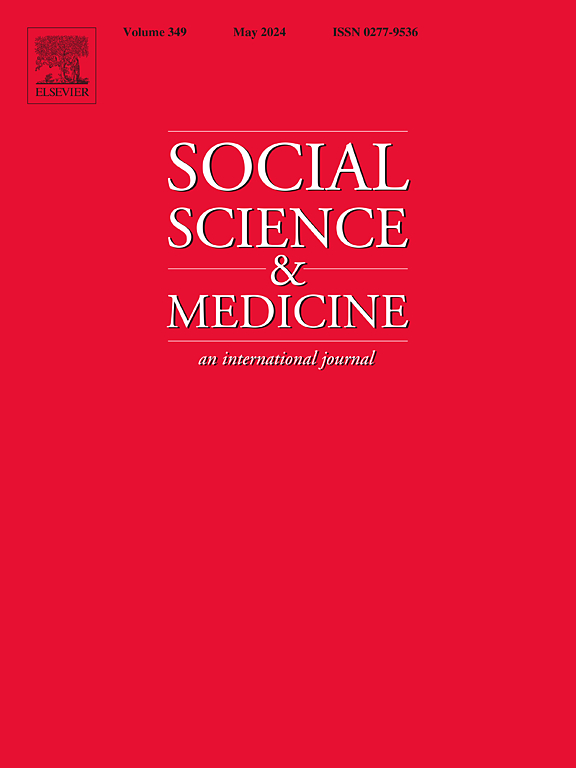“控制流动”移徙战略和通过巴拿马达里萨伊姆“过境”人员的人道主义照顾制度
IF 5
2区 医学
Q1 PUBLIC, ENVIRONMENTAL & OCCUPATIONAL HEALTH
引用次数: 0
摘要
自2021年以来,已有超过100万人徒步穿越巴拿马和哥伦比亚之间的达里姆边境地区,前往美墨边境。这条路线的极端物理条件是,穿越河流和山脉,穿过达里萨丹森林,极易遭受暴力,并对移徙者的健康产生影响。随着达里萨丹境内移徙人数的增加和多样化,复杂的医疗紧急情况,包括移徙者死亡、性暴力和伤害,成为社会服务应对的关键领域。自2016年以来,巴拿马国家实施了“控制流动”移民战略,近年来,非政府组织通过移民接待中心系统提供基本服务。我们的研究基于人种学方法,包括参与者观察、健康调查和与移民服务官员的半结构化访谈(n = 39),研究了人们在穿越达里萨芬森林的险恶地形后,基于对暴力的医疗反应,提供护理的日常条件和局限性。我们追踪巴拿马的移民政策如何建构暴力,以及如何塑造经由巴拿马“过境”的移民获得人道关怀的可能性。通过分析区域边境制度对公共卫生的影响,我们深化了对移民照顾和控制的关系的研究,该关系为穿越达里姆省前往美国南部边境的移民增加制定了人道主义应对措施。本文章由计算机程序翻译,如有差异,请以英文原文为准。
The “controlled flow” migration strategy and regimes of humanitarian care for people “in transit” through Darién, Panama
Since 2021, over one million people have traveled on foot across the Darién border region separating Panama and Colombia en route to the U.S.-Mexico border. Extreme physical conditions of the route, crossing rivers and mountains through the Darién Forest, present lethal vulnerabilities to violence and impacts on migrant health. As migration across Darién has increased and diversified, complex medical emergencies, including migrant death, sexual violence, and injury, present critical areas for social service response. Since 2016, the Panamanian State has implemented the “controlled flow” migration strategy and, in recent years, non-governmental organizations provide basic services through a system of migrant reception centers. Our research, based on ethnographic methods including participant observation, health surveys, and semi-structured interviews (n = 39) with migrant-serving officials examines the everyday conditions and limitations to the provision of care based on a medicalized response to violence after people traverse the treacherous terrain across the Darién Forest. We trace how migration policies in Panama construct violence and shape the possibilities for humanitarian care for migrant people “in transit” through Panama. This paper advances understanding of the impacts of border externalization on shaping mobility, migrant protection, and regimes of care in transit corridors along the route to the U.S. By analyzing the public health impact of a regional border regime, we deepen research on the nexus of migrant care and control that frames the humanitarian response to increased migration across Darién Province for people traveling to the U.S. southern border.
求助全文
通过发布文献求助,成功后即可免费获取论文全文。
去求助
来源期刊

Social Science & Medicine
PUBLIC, ENVIRONMENTAL & OCCUPATIONAL HEALTH-
CiteScore
9.10
自引率
5.60%
发文量
762
审稿时长
38 days
期刊介绍:
Social Science & Medicine provides an international and interdisciplinary forum for the dissemination of social science research on health. We publish original research articles (both empirical and theoretical), reviews, position papers and commentaries on health issues, to inform current research, policy and practice in all areas of common interest to social scientists, health practitioners, and policy makers. The journal publishes material relevant to any aspect of health from a wide range of social science disciplines (anthropology, economics, epidemiology, geography, policy, psychology, and sociology), and material relevant to the social sciences from any of the professions concerned with physical and mental health, health care, clinical practice, and health policy and organization. We encourage material which is of general interest to an international readership.
 求助内容:
求助内容: 应助结果提醒方式:
应助结果提醒方式:


